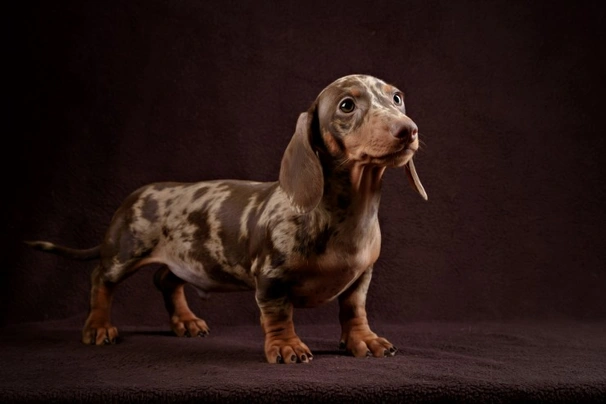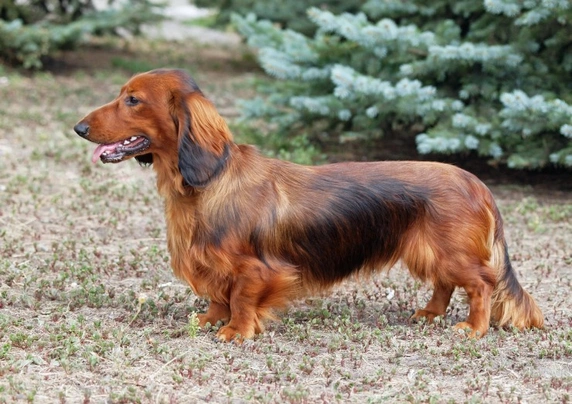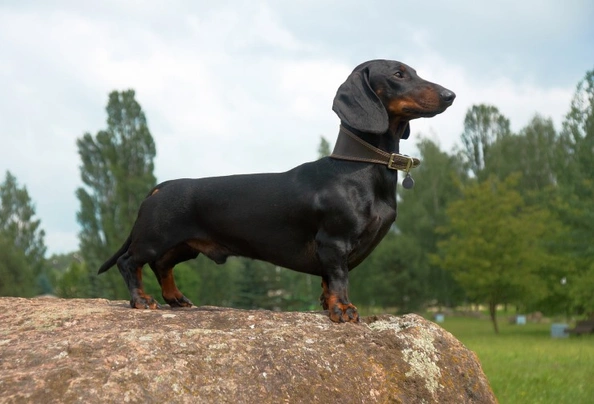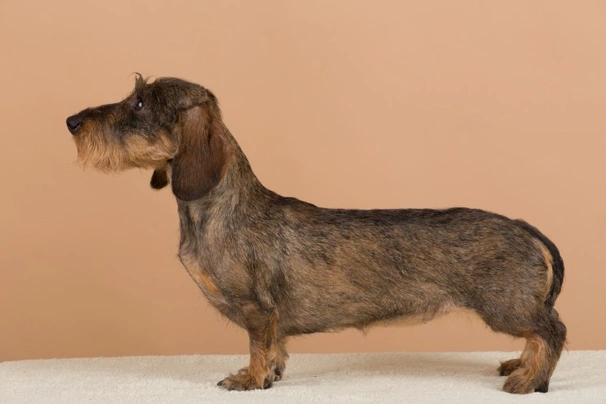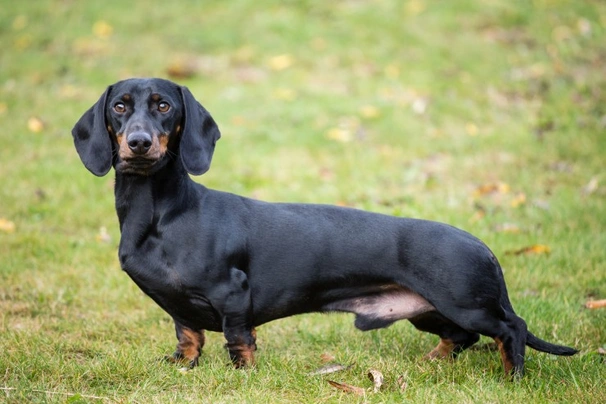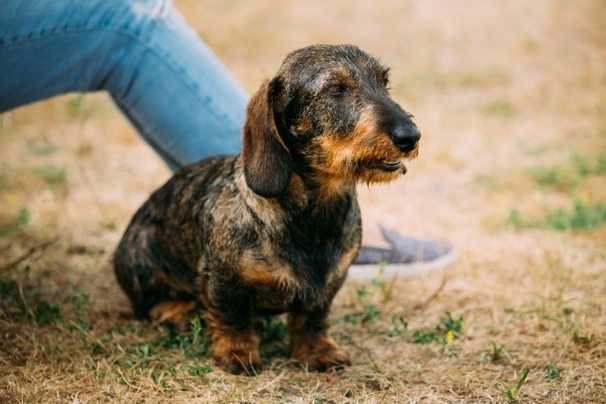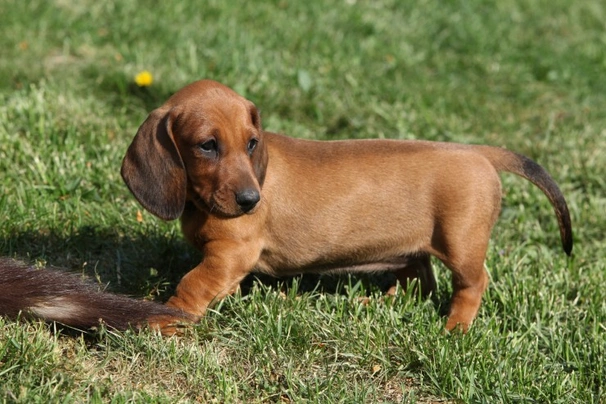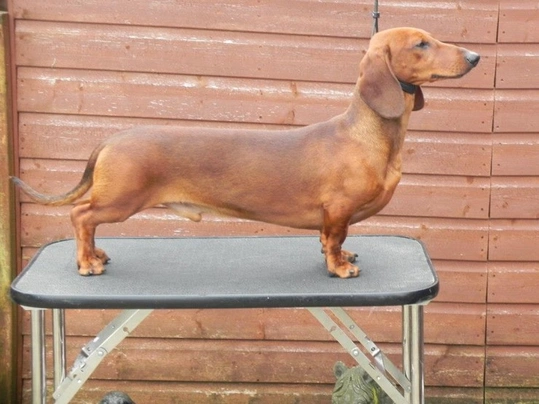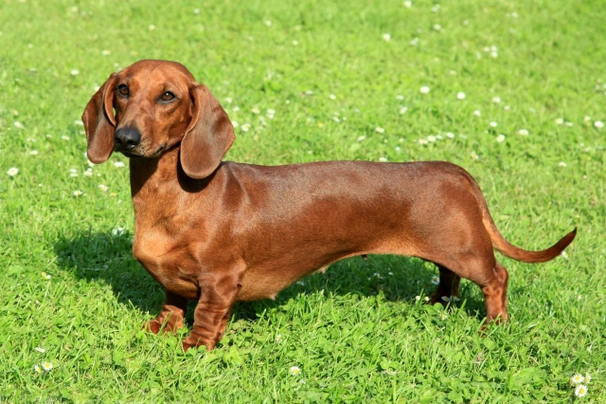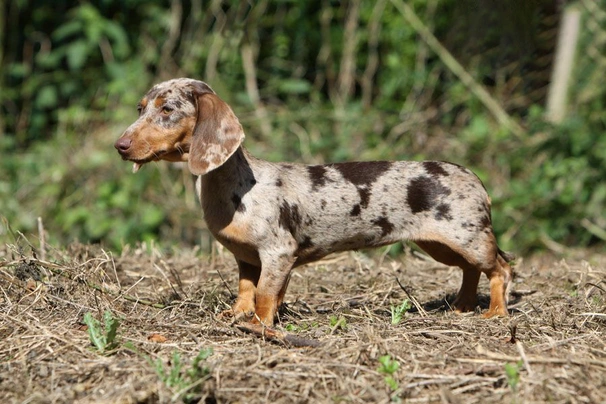Dachshund
Pros
Cons
Introduction of the Dachshund
Dachshunds are very unique and active little dogs that over the years have found their way into the hearts and homes of many people both in the UK and elsewhere in the world. Although small in stature a Dachshund thrives on keeping busy and will happily take as much exercise as an owner would give them. The breed originates from Germany where they were bred to hunt rabbits badgers and wounded game. There's nothing these dogs like more than being out and about chasing down a scent but they are just as happy to curl up on a sofa next to their owner at the end of the day. Dachshunds are intelligent loyal companions and they love being part of a household.
However they are known to be a little bit stubborn which means they are not the easiest dogs to train which includes house training them too. Add to this the "hound" in these little dogs and the result can often be a Dachshund that chooses to ignore the recall command so they can go off after something that has taken their fancy. There are in fact 6 types of Dachshund and all of them boast being great fun characters to have around which is why they have consistently remained one of the most popular breeds in the world.
History of the Dachshund
Dachshunds have been around for a very long time with records of these little dogs dating back to the 15th century in their native Germany. With this said evidence of similar dogs can be seen in art from the time of the Ancient Egyptians. Dogs much like the Dachshund have also been found in ancient artworks found in Mexico. Other evidence of similar dogs was found in Italy that date back to the first century AD.
Their name means "badger dog" in German and it is thought the breed came about by crossing the Schweisshund with the Bibarhund and through selective breeding shorter legged dogs were created by the 18th Century. These shorter legged dogs were specifically bred to hunt and to flush prey which included badgers out of their dens when they went to ground. Again through further selective breeding smaller versions of the Dachshund were created which were to become the miniature Dachshunds which were highly prized by foresters because they could get down rabbit holes to flush out their prey.
Throughout time in their native Germany the breed has been divided into three groups which was based on a dog’s size with the first being the Standard Dachshund or Normalgrosssteckel the second and the third being the miniature Dachshund which again in Germany were divided into two types namely the Zwergteckel or dwarf Dachshund and they Kaninchenteckel or rabbit Dachshund.
The breed was extremely popular throughout Europe and America right up to the First World War when they were among the top ten breeds with Dachshunds having first been introduced to the UK in 1840 after the Prince Consort was given several smooth-haired dogs by the Prince Edward of Saxe-Weimar. The Prince kept his Dachshunds in Windsor Castle and often used them on pheasant shoots that were organised on the estate back in the day.
The first ever Dachshund dog show was held in England in 1859 and the breed's popularity was helped by Queen Victoria who was a huge fan of the breed and who continued to improve and promote them throughout her reign.
However with the outbreak of World War I and the World War II the breed fell out of favour thanks to the German connection. Fortunately breed enthusiasts ensured the breed regained their popularity not only in the UK but in the United States and other countries of the world too.
Today the Dachshund remains one of the most popular small dogs in the UK thanks not only to their adorable looks but also because they boast such kind and loyal natures and there are in fact 6 varieties of Dachshund in the UK.
Interesting facts about the breed
- Is the Dachshund a vulnerable breed? No they are among one of the most popular dogs in the UK
- In France the name Dachshund is Basset
- In Switzerland the name Dachshund is Neider
- Queen Victoria was a huge fan and worked hard to promote and improve the breed
Appearance of the Dachshund
Height at the withers: Males 20 - 27 cm Females 20 - 27 cm
Average weight: Males 9 - 12 kg Females 9 - 12 kg
There is no mistaking a Dachshund for any other breed although there are 6 varieties of these charming little dogs which can sometimes cause confusion. Often called Sausage Dogs thanks to their short legs and long bodies they are well muscled compact dogs that boast powerful front legs which are perfectly put together for digging. They boast long almost conical shaped heads with a very slightly arched skull and their muzzle lacks a very prominent stop. They boast strong jaws and tight lips.
Their eyes are almond-shaped and medium in size and set obliquely. Dachshunds boast dark eyes although chocolate coloured Dachshunds have lighter eyes and in dogs with dapple coats either one or both can be "wall eyes" which is acceptable as a breed standard. Their ears are set high and broad being moderately long with the forward edge of their ears touching a dog's cheeks. When Dachshunds are alerted by anything they carry their ears forward and outward.
Their mouth is well developed and powerful with teeth that fit tightly together. They boast a perfect scissor bite where their upper teeth neatly overlap their lower ones. Necks are long and muscular which dogs hold slightly arched and which run nicely into a dog's shoulders. Dachshunds carry their heads proudly forward which gives them these little dogs a very defiant trademark look.
Shoulders are broad with dogs boasting long shoulder blades and their front legs are well muscled and strong. A Dachshund's body is extremely well muscled and moderately long with nicely sloping shoulders and they have quite a level back with a slightly arched short and strong loin. Their breastbone is prominent and dogs are well ribbed with slightly curved abdomens that allow enough clearance from the ground for dogs to move about freely.
Their hindquarters are powerful and well-muscled with dogs boasting a broad full rump and long croup that slopes slightly towards their tail. Their upper thigh is strong and set at a right angle to a dog's pelvis while the well-muscled lower thigh is set at a right angle to a dog's upper thigh. Their front feet are broad full and close knit with a dog's back feet being slightly narrower and smaller. Toes are closed with a distinct arch to each of them. Nails are strong and well placed with dogs boasting firm thick paw pads. Their tail continues the line of a Dachshund's spine with dogs carrying them slightly curved.
When it comes to their coat a smooth haired Dachshund has a short and dense one with the hair underneath their tail being coarser in texture. Their skin is supple and loose but showing only a little or no wrinkles. Dachshunds can be any colour with the only exception being white. With this said dogs can have a small amount of white on their chest although it is not encouraged. Acceptable colours under the Kennel Club breed standard are as follows:
- Black & Cream
- Black & Cream Brindle
- Black & Tan
- Black & Tan Brindle
- Chocolate & Cream
- Chocolate & Cream Brindle
- Chocolate & Tan
- Chocolate & Tan Brindle
- Chocolate Dapple & Cream
- Chocolate Dapple & Tan
- Chocolate Dapple & Tan Brindle
- Chocolate Dapple Cream Brindle
- Cream
- Cream Brindle
- Cream Brindle Dapple
- Cream Dapple
- Red
- Red Brindle
- Red Brindle Dapple
- Red Dapple
- Shaded Cream
- Shaded Red
- Silver Dapple & Cream
- Silver Dapple & Cream Brindle
- Silver Dapple & Tan
- Silver Dapple & Tan Brindle
Potential owners are strongly advised not to be tempted into buying Dachshunds described as having "rare colours" and this includes the following:
- Double Dapple - Kennel Club registration would be refused
- Piebald - Kennel Club registration as Colour Not Recognised
- Blue - Kennel Club registration as Colour Not Recognised
- Isabella - Kennel Club registration as Colour Not Recognised
The reason why the Kennel Club does not accept the above colours in Dachshunds is due to the health risks associated with them. It is worth noting that breeders would not be able to prove a puppy's pedigree should they be any of the above colours
More about Dapple
The Kennel Club breed standard states that there should be not white in a Dachshund's coat other than in the dapple pattern dogs. Dapple coats are described under the KC standard as being a dog with a lighter coloured patches on a contrasting darker coloured base with neither the dark or lighter colour being the predominant colour. Even a small spot of white on a Dachshund's chest is in fact undesirable under the KC breed standard.
When it comes to "dapple" in the breed this describes a coat that is the same both genetically and in appearance to that of a merle Collie and the Australian Shepherd as well as some other breeds. In Dachshunds the dappling can be very obvious whereas in other dogs it may be less noticeable with the most obvious typically being seen on darker bases which includes the following:
- Black and Tan (Silver Dapple)
- Red and tan
- Chocolate and tan
More about Double Dapple
As previously mentioned a Dachshund with a Double Dapple coat (from two Dapple parents) would be refused Kennel Club registration because of the health issues associated with the colour and the fact that both parent Dachshunds have dapple coats. Double Dapple dogs always have some white in their coats quite similar to that of a Border Collie namely a band that goes around a dog's neck paws being white and the tip of the tail being white too. Double Dapple Dachshunds often have blue eyes whether it is one or both.
The health risks associated with Double Dapple Dachshunds is so great that the Kennel Club strongly advises that breeder should not breed 2 dapple coated Dachshunds at any time. The health problems associated with double dapple are as follows:
- Impaired vision with some Dachshunds being totally blind
- Impaired hearing with some Dachshunds being totally deaf
It is worth noting that Dachshunds with single Dapple coats are not at risk of having impaired vision or hearing. It is also worth noting that Dapple and Piebald are totally different with both being caused by different genes. The Dapple being the dominant gene whereas the Piebald is recessive and as such there is less risk of puppies bred from two piebald Dachshunds being affected by the health risks associated with Dapple coated dogs when bred together. With this said breeders are advised not to breed a Piebald Dachshund to a Dapple.
Health risks associated with 'dilute'colours in the Dachshund
Blue (now sometimes referred to as lilac) - dogs may have a predisposition to a condition known as colour dilution alopecia as such this colour is highly undesirable under the Kennel Club breed standard
Isabella - dogs may have a predisposition to a condition known as colour dilution alopecia as such this colour is highly undesirable under the Kennel Club breed standard
Gait/movement
When Dachshunds move they do so freely with a naturally flowing action that sees their strides being long with lots of power being generated from their hindquarters when seen from the side. Their legs should move parallel to one another when from behind or from the front and the distance from each other being that of their shoulders and hips respectively.
Faults
The Kennel Club frowns on any exaggeration or departure from the breed standard and the seriousness of the fault would be judged on how much it affects a dog's health and welfare.
Temperament of the Dachshund
Once a Dachshund is fully mature they are active little dogs and as such they love being out and about doing things which often sees them tiring their owners out well before they are ready to go home. With this said they like nothing more than to curl up with their owners whenever they are given the chance. Dachshunds are renowned for being loyal companions that over the years have become popular family pets and companion dogs for this very reason.
Although they are intelligent Dachshunds tend to have a mind of their own which in short means they are not the best in the obedience stakes. Their instinct to "hunt" also remains very strong and as such a Dachshunds training must start early paying particular attention to the "recall" command and even then a dog might choose to ignore it because something more interesting has caught their attention.
It would be fair to say that in general Standard Wirehaired Dachshunds are the more active and extrovert dogs by nature with Standard Longs being a lot more easy-going and laid-back. Standard Smooths also tend to be more one-person dogs by nature although they can also be "one-family" dogs too.
Dachshunds are not the best choice for first time owners because they are better suited to people who are familiar with the breed and their specific needs which includes the health concerns the breed is known to suffer from. If not trained and handled correctly from the word go these little dogs can become unruly and wilful which makes it hard for owners to manage them. However in the right hands and a lot of patience it is possible to overcome their stubborn streak always bearing in mind as previously touched upon that if a Dachshund picks up a whiff of anything that's more interesting they are liable to take off after it.
They can be a little wary of strangers and are always quick to let an owner known when there is anyone about. For such little dogs the Dachshund boasts a deep bark which often surprises people when they first see them after having heard them bark. Another thing to bear in mind is that if a Dachshund is not given the right amount of daily exercise and mental stimulation they quickly get bored and they will develop unwanted behaviours one of which is separation anxiety.
Are they a good choice for first time owners?
Dachshunds are not the best choice for first time dog owners because they can be a little difficult to train and because they are prone to certain health issues they are better suited to people who are familiar with their needs and who therefore know that it takes time and patience to train Dachshunds which includes when housetraining these little dogs.
What about prey drive?
Dachshunds were bred to hunt and therefore they have a powerful prey drive which is a trait that is deeply embedded in their psyche. As such care should always be taken as to when and where a Dachshund is allowed to run free off their leads.
What about playfulness?
Dachshunds are active fun-loving little dogs and they thrive on being the centre of attention. They adore being entertained while at the same time they enjoy entertaining their owners with all their silly antics. They are renowned for being real clowns when the mood takes them and they quickly learn how to please their owners.
What about adaptability?
Dachshunds are highly adaptable little dogs which means they are just as happy living in an apartment in town as they would be living in a house in the country providing they are given enough exercise and mental stimulation bearing in mind that Dachshunds like to be out and about doing something.
What about excessive barking?
If not taught the "quiet" command from a young enough age some Dachshunds will bark excessively for any reason but because they are such smart dog they can be taught not to providing their education is done gently yet firmly so as not to scare them into being quiet.
Do Dachshunds Like Water?
Because of their build and the fact they have such short legs Dachshunds are not particularly good swimmers and care should always be taken when walking a dog anywhere near anywhere near water just in case they fall in.
Are Dachshunds good watchdogs?
Dachshunds like to let an owner know when there are strangers about or when something they don't feel comfortable about is going on in their environment and they have a surprisingly deep bark for such small dogs which often takes people by surprise.
Intelligence / Trainability of the Dachshund
The Dachshund is known to be an intelligent little dog yet they are not that easy to train thanks to the fact they have a mind of their own and are quite independent by nature which can be put down to the "hound" in them. However in the right hands and when they are given the right amount of positive reinforcement training from a young age as well as a lot of persistence and patience Dachshunds can be trained although they would never be 100% obedient simply because if they spot something in the distance and because they are highly skilled hunters turning a "deaf ear" to a command when they off their leads is something that all Dachshund owners should bear in mind.
They can be a little harder to housetrain than other breeds but with patience gentleness and a firm hand a Dachshund can be taught to do their "business" outside. Puppies must be taught the house rules and boundaries as soon as they arrive in their new homes and although they are incredibly cute it would be a mistake to let a Dachshund puppy get away with too much which could see them develop a condition known as Small Dog Syndrome. This makes dogs a lot harder to manage and handle because they start to show a more dominant side to their natures. Puppies need to be taught the following commands from the word go:
- Sit
- Stay
- Come
- Heel
- Lie down
- Bed
- Quiet
Children and other
Smooth haired Dachshunds are known to be good around children especially if they have grown up together. However just like any other breed any interaction between the kids and dog has to be supervised by an adult to make sure play time does not get too boisterous.
Generally they get on with other dogs and they rarely show any sort of aggressive behaviour towards them. However when it comes to smaller animals and pets care needs to be taken when a Dachshund comes into contact with them and this includes cats. With this said if they have grown up with a cat they are generally more tolerant of them.
Health of the Dachshund
The average life expectancy of a Dachshund is between 12 and 13 years when properly cared for and fed an appropriate good quality diet to suit their ages.
One of the most concerning health issues seen in Dachshunds of all varieties is Intervertebral Disc Disease (IVDD) which affects their spines and this is related to the dwarfism gene which causes their short legs. As a result the breed is known to be at a higher risk of spinal injuries than some other breeds. IVDD X-ray screening is now available for breeding dogs to help reduce the inherited risk. It is also essential that care be taken when sharing a home with a Dachshund puppy. Jumping up on furniture or running up and down stairs can cause damage to a growing Dachshund's spine so must be avoided at all costs.Other health issues that affect the breed include the following:
- Intervertebral Disc Disease (IVDD) - test available
- Progressive Retinal Atrophy (NPHP4) - test available (note different form of PRA from that in miniatures)
- Patellar luxation
- Epilepsy
- Thyroid problems
- Cushing’s syndrome
- Allergies/skin issues
- Obesity
How a dog's conformation can affect their health
Dachshunds are robust little dogs that can take as much exercise as their owners give them even though they have such short legs. A Dachshund's chest should never be too deep either. The Kennel Club frowns on any exaggeration or departure from the breed standard because very short legs can seriously affect their ground clearance which in turn can affect their free movement and reduce their ability to walk far.
What about vaccinations?
A Dachshund puppy may have been given their initial vaccinations before being sold and the information relating to when they were given their shots would be included in the puppy pack a reputable breeder would provide to new owners. Once a puppy arrives in their new homes it is up their owners to ensure they are given future vaccinations with the schedule being as follows:
- 10 -12 weeks old bearing in mind that a puppy would not have full protection straight away but would be fully protected 2 weeks after they have had their second vaccination
There has been a lot of discussion about the need for dogs to have boosters. As such it's best to talk to a vet before making a final decision on whether a dog should continue to have annual vaccinations which are known as boosters.
What about spaying and neutering?
The latest evidence suggests that early spaying or neutering can adversely affect the future health of a Dachshund (including the potential impact on muscle and skeletal structure given that they are prone to back issues). If there is a good medical reason to spay or neuter a Dachshund this should preferably not be done before the dog is fully mature (at least 12 months)
What about obesity problems?
In general Dachshunds are such active little dogs that they are not prone to putting on too much weight. However it is crucial for them to be fed an appropriate diet in the right daily quantities and to limit the amount of "food" treats a dog is given to prevent them from ploughing on the pounds. Obesity can seriously affect a Dachshund's health and well-being making it that much harder for them to move and it could shorten their lives by several years thanks to the extra pressure it puts on their joints and internal organs.
What about allergies?
Some Dachshunds are more prone to allergies than others and it can be very hard to establish just what triggers a reaction in a dog. The typically causes of allergies seen in the breed include the following:
- Diet
- A reaction to cereals often used in commercially produced dog foods
- Environment
- Seasonal allergies triggered by pollens and grasses
- Chemicals often found in many household cleaning products
- A reaction to flea and tick bites
Participating in health issues
Any Dachshund that will be bred from should ideally participate in the IVDD Screening Programme more information available from the Dachshund Breed Council.
What about breed specific breeding restrictions?
Dachshund puppies cannot be registered with the Kennel Club if both parent dogs are dapple because of the health risks associated with their mating which can seriously affect a Dachshund's sight and hearing.
Same breed Dachshund parents can produce puppies with a different coat and they can be registered with the Kennel Club to the breed their coats most closely conform too but this rule does not permit the interchange of Dachshunds of two different sizes.
What about Assured Breeder Requirements?
There are no specific health test requirements for Standard Dachshunds under the Kennel Club Assured Breeders scheme.
Caring for the Dachshund
As with any other breed Dachshunds need to be groomed on a regular basis to make sure their coats and skin are kept in top condition. They also need to be given regular daily exercise to ensure they remain fit and healthy. On top of this they need to be fed good quality food that meets all their nutritional needs throughout their lives.
Caring for a Dachshund puppy
It's important to set things up properly in the home before bringing a Dachshund puppy home and it's also a good idea to get the timing right too. This means making sure that someone will be at home for a few days and even up to a week to help settle a puppy into their new environment. Puppy-proofing the home is essential and it's a good idea to limit the amount of space a puppy can roam around in. Electric wires and other things that a puppy might chew should be put out of their reach and fitting child gates on doors to prevent a puppy from having free access to the whole house is also a good idea. Another option is to invest in a well-made playpen which is a great way of ensuring a puppy cannot get into trouble and it makes it easier to keep an eye on them.
It's also important to set up a quiet area where puppy can nap when they need to bearing in mind that puppies need to sleep a lot which can be up to 21 hours in a twenty-four hour period. With this said it should not be too out of the way because a new puppy needs to know someone is around and they are not on their own while at the same time owners can hear their new pets should they get anxious or in trouble.
It's also important to set up an area where puppy training pads can be placed which can be in the playpen or near the "quiet" area a puppy takes their nap in. With this said a puppy's housetraining must begin as soon as possible which means keeping an eye on when they need to go to the toilet and making sure they are either let outside to do their business or placed on a puppy pad always making sure a puppy is well rewarded when they get it right. It can take a little more time and patience to train a Dachshund but with gentle perseverance they can be taught to do their business in the right places.
The documentation a breeder provides for a puppy must have all the details of their worming date and the product used as well as the information relating to their microchip. It is essential for puppies to be wormed again keeping to a schedule which is as follows:
- Puppies should be wormed at 6 months old
- They need to be wormed again when they are 8 months old
- Puppies should be wormed when they are 10 months old
- They need to be wormed when they are 12 months old
Things you'll need for your puppy
Getting the house ready for a new puppy's arrival is only part of the process because there are certain items which should be purchased well in advance and this includes the following:
- Food and water bowls making sure they are not too deep and ideally they should be ceramic rather than metal or plastic
- A collar of the right size. All dogs should be trained to walk without pulling but for dachshunds it is particularly important as it could put extra pressure on their neck and spine. Some owners prefer to use a harness but this can make training more difficult as dachshunds can be very stubborn!
- A well-made playpen
- Child gates to fit on doors
- Dog specific toothpaste and tooth brush
- Grooming tools which includes shampoo specifically formulated for use on dogs
Keeping the noise down
All puppies are sensitive to loud noises which can stress them out more especially when they first arrive when they are naturally already quite worried having just left their mothers and littermates. It's important not to play loud music and to set the volume of a television or other device at a quieter level so it does not disturb a puppy's sensitive hearing.
Keeping vet appointments
As previously mentioned some puppies are given their first shots before being sold but it's important for them to have their follow-up shots at the right time with the schedule being as follows:
- 10 -12 weeks old bearing in mind that a puppy would not have full protection straight away but would only be fully protected 2 weeks after they have had their second vaccination
When it comes to boosters it's best to discuss these with a vet because there is a lot of debate about whether a dog really needs them after a certain time. However if a dog ever needed to go into kennels their vaccinations would need to be
What about Dachshunds when they reach their golden years?
Because Dachshunds are prone to suffering from spinal issues when they reach their golden years some dogs develop arthritis so it's important for them to be routinely checked over by a vet. Older dogs have weaker immune systems which puts them more at risk of catching an infection so it's important to keep a close eye on their health when they reach their golden years. Other changes that affect an older dog include the following:
- Dogs start to get grey around their muzzles and faces
- Their eyes might look a little opaque which can be age related or it could be because of an underlying health issue that would need investigating by a vet
- The hearing might not be as good as when they were young which often means a dog does not respond as quickly as they once did
- Older dogs tend to sleep a lot more during the day
- They often get a little pickier about their food which is why it's important to rethink a dog's diet and to discuss things with the vet if there are any concerns about the condition of an older dog's overall health and well-being
- Older dogs often seem disoriented which can be put down to the fact their cognitive function is not as sharp as it once was
- An older Dachshund’s immune system might not be as strong as it once was which puts them more at risk of infection and developing diseases and illnesses which is why they need to be seen more often by a vet
Grooming of the Dachshund
Smooth haired Dachshunds are low maintenance in the grooming department thanks to their coats being so short. A quick brush over with a chamois leather keeps their coats gleaming. However these little dogs love the one-to-one contact they get during a grooming session and it allows owners to check their dog's skin and to make sure there are no lumps and bumps developing anywhere on their body.
Puppies need to be taught that grooming is an enjoyable experience from an early age so they look forward to being brushed and don't get upset when their ears or feet are touched. It's a good idea to check a Dachshunds ears on a regular basis and to clean them when necessary.
Grooming tools needed for a Dachshund
Sharing a home with a Dachshund means investing in the right grooming tools to keep their coats and skin in good condition. Regular grooming sessions also help keep an eye out for any skin conditions that may be flaring up and to catch a problem before it becomes harder to treat. The grooming tools needed for a Dachshund are as follows:
- A slicker brush
- A bristle brush
- A chamois leather
- A grooming glove
- Nail clippers
- A pair of round ended scissors
- Dog specific shampoo and conditioner
Exercise of the Dachshund
Although small in stature Dachshunds need to be given quite a lot of daily exercise for them to be truly happy well balanced dogs. A minimum of an hour a day is necessary which means taking a dog out for a quick walk in the morning of 20 minutes or so but in the afternoon their walk needs to be longer and ideally it should be around 40 minutes or so. As previously mentioned if not given enough exercise every day these little dogs can develop some unwanted and destructive behavioural issues which includes suffering from separation anxiety.
They also like to be able to run around a back garden as often as they can so they can really let off steam. However the fencing has to be very secure bearing in mind that Dachshunds are incredibly good at digging their way out under a fence when the mood takes them bearing in mind their front legs are designed for these little dogs to be expert diggers.
Feeding of the Dachshund
If you get a Dachshund puppy from a breeder they would give you a feeding schedule and it's important to stick to the same routine feeding the same puppy food to avoid any tummy upsets. You can change a puppy's diet but this needs to be done very gradually always making sure they don't develop any digestive upsets and if they do it's best to put them back on their original diet and to discuss things with the vet before attempting to change it again.
Older dogs are not known to be fussy or finicky eaters but this does not mean you can feed them a lower quality diet. It's best to feed a mature Dachshund twice a day once in the morning and then again in the evening making sure it's good quality food that meets all their nutritional requirements. It's also important that dogs be given the right amount of exercise so they burn off any excess calories or they might gain too much weight which can lead to all sorts of health issues. Obesity can shorten a dog's life by several years so it's important to keep an eye on their waistline from the word go.
Feeding guide for a Dachshund puppy
As a rough guide a Dachshund puppy can be fed the following amounts every day to ensure they are getting the right levels of nutrients for them to grow and develop properly:
- 2 months old - 66g to 152g depending on puppy's build
- 3 months old - 75g to 179g depending on puppy's build
- 4 months old - 78g to 190g depending on puppy's build
- 5 months old - 78g to 193g depending on puppy's build
- 6 months old - 71g to 193g depending on puppy's build
- 7 months old - 64g to 174g depending on puppy's build
- 8 months old - 56g to 156g depending on puppy's build
- 9 months old - 56g to 139g depending on puppy's build
- 10 months old - 55g to 138g depending on puppy's build
Once a puppy is 11 months old they can be fed adult dog food.
Feeding guide for an adult Dachshund
As a rough guide an adult Dachshund can be fed the following amounts every day making sure a dog is not given too many "food" treats in between meals:
- Dogs weighing 9 kg can be fed 131g to 154g depending on activity
- Dogs weighing 10 kg can be fed 143g to 166g depending on activity
- Dogs weighing 12 kg can be fed 152g to 108g depending on activity
Dachshund price
If you are looking to buy a Dachshund you would need to pay anything from £500 to over £1600 for a well-bred pedigree puppy. Insurance costs should also be factored in when buying a dachshund. The cost of insuring a male 3-year-old Dachshund in northern England would be £20.39 a month for basic cover but for a lifetime policy this would set you back £41.22 a month (quote as of April 2016). When insurance companies calculate a pet's premium they factor in several things which includes where you live in the UK and a dog's age and whether they have been neutered or spayed.
When it comes to food costs you need to buy the best quality food whether wet or dry to feed your dog throughout their lives making sure it suits the different stages of their lives. This would set you back between £30 - £40 a month. On top of this you would need to factor in veterinary costs if you want to share your home with a Dachshund and this includes their initial vaccinations their annual boosters the cost of neutering or spaying your dog when the time is right and then their yearly health checks all of which quickly adds up to over a £1000 a year.
As a rough guide the average cost to keep and care for a Dachshund would be between £60 to £100 a month depending on the level of insurance cover you opt to buy for your dog but this does not include the initial cost of buying a well-bred pedigree Dachshund puppy.
Buying advice
When visiting and buying any puppy or dog there are many important things to consider and questions to ask of the breeder/seller. You can read our generic puppy/dog advice here which includes making sure you see the puppy with its mother and to verify that the dog has been wormed and microchipped.
Dachshunds are an extremely popular breed both in the UK and elsewhere in the world which means that well-bred puppies command a lot of money. As such with Dachshunds there is specific advice questions and protocols to follow when buying a puppy which are as follows:
- As previously touched upon Dachshunds are among the most popular breeds in the UK. As such there are many amateur breeders/people who breed from a Dachshund far too often or buy cheaply from puppy farms and claim they are home bredso they can make a quick profit without caring for the welfare of the puppies their dam or the breed in general. Under Kennel Club rules a dam can only produce 4 litters and she must be between a certain age to do so. Anyone wishing to buy a Dachshund puppy should think very carefully about who they purchase their puppy from and should always ask to see the relevant paperwork pertaining to a puppy's lineage their vaccinations and their microchipping.
- Potential owners should be aware the Kennel Club has strict rules on coat colours for the Dachshund and that Double Dapple Dachshunds cannot be registered with the Kennel Club because of the health issues associated with this pattern which results in a dog's hearing and vision being severely impaired. As above ‘dilute’ colours such as ‘blue’ ‘lilac’ or ‘isabella’ colour dogs are at risk at developing severe alopecia Any breeder that advertises puppies with "rare" coats should be avoided at all costs and reported to the right authorities.
- Beware of online scams and how to avoid them. You may see online and other adverts by scammers showing images of beautiful Dachshund puppies for sale at very low prices. However the sellers ask buyers for money up front before agreeing to deliver a puppy to a new home. Potential buyers should never buy a puppy unseen and should never pay a deposit or any other money online to a seller. You should always visit the pet at the sellers home to confirm they are genuine and make a note of their address.
